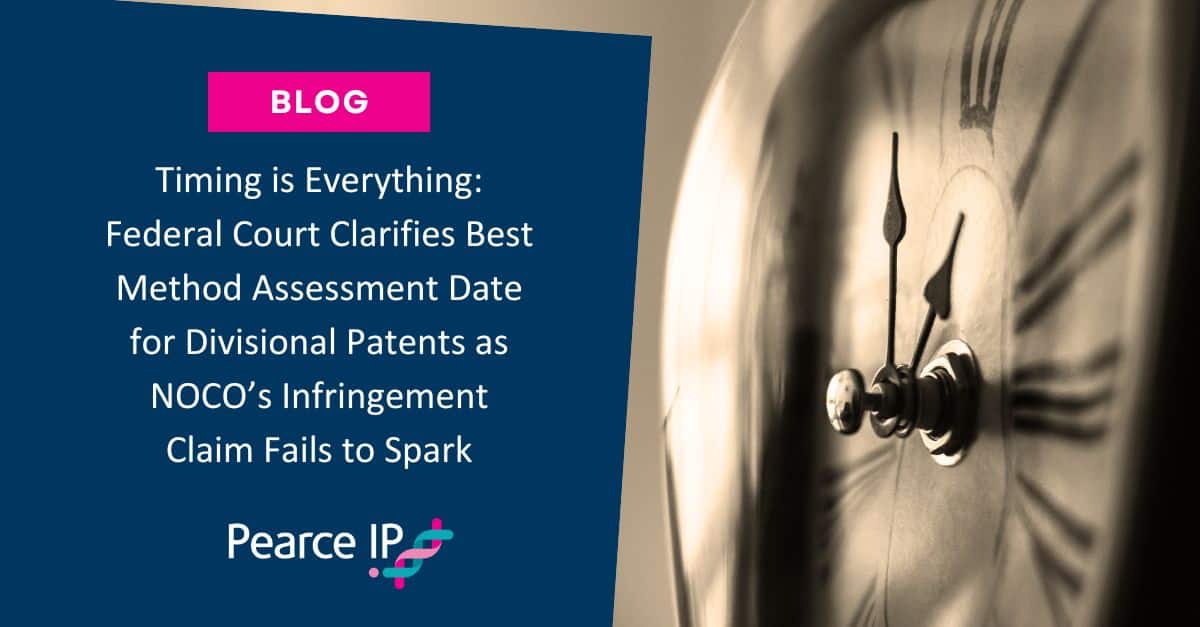| Date of decision: | 7 August 2025 |
| Body: | Federal Court of Australia |
| Adjudicator: | Justice Moshinsky |
Introduction
Justice Moshinsky of the Federal Court has delivered judgment in patent proceedings between The NOCO Company (NOCO) and Brown & Watson International Pty Ltd (B&W) relating to portable vehicle battery jump starters. In a complete victory for B&W, Justice Moshinsky found all asserted claims across three patents to be invalid. The decision offers valuable insights into the sufficiency requirements for claiming priority from earlier applications, and clarifies that best method disclosure obligations are assessed at the filing date of the earliest complete application from which the patent term runs.
Background
The case concerned three Australian patents held by US company NOCO, relating to portable vehicle battery jump starter apparatus with safety protection:
- 2020201223 (the 223 Patent)
- 2021258059 (the 059 Patent)
- 2022201338 (the 338 Patent)
All three patents are from the same family, each claiming priority from PCT/US2014/045434 (the PCT Application) filed on 3 July 2014.
The patents address safety problems with traditional jump starter devices, where jumper cables could accidentally contact each other or be connected with reverse polarity, causing sparking and potential injury. The patented solution involves a control system that detects both battery presence and correct polarity before allowing a power switch to connect the internal battery to the external vehicle battery.
NOCO brought proceedings against B&W, alleging infringement of the patents by B&W’s ‘Projecta’ brand jump starters. B&W cross-claimed, seeking to invalidate all asserted claims on grounds of lack of novelty, lack of inventive step, failure to disclose the best method, lack of support, insufficiency and lack of utility. Justice Moshinsky addressed all grounds of invalidity except lack of support, insufficiency and lack of utility in his judgment, these grounds being unnecessary for his Honour to decide given his findings on the other invalidity grounds.
Although many claims were in issue, considerable attention was given to Claim 1 of the 223 Patent, which is in the following terms:
- 1.1 A jump starter apparatus for boosting or charging a depleted or discharged battery having a positive battery terminal and a negative battery terminal, the apparatus comprising:
- 1.2 a power supply;
- 1.3 a positive battery connector for connecting the jump starter apparatus to the positive battery terminal of the depleted or discharged battery;
- 1.4 a negative battery connector for connecting the jump starter apparatus to the negative battery terminal of the depleted or discharged battery;
- 1.5 a power switch connected in circuit with the power supply and the positive and negative battery connectors, the power switch configured to turn power on or off from the power supply to the positive and negative battery connectors;
- 1.6 a control system or circuit connected to and controlling the power switch, the control system or circuit configured to detect presence of the depleted or discharged battery when connected between the positive and negative battery connectors and to detect polarity of the depleted or discharged battery when connected between the positive and negative battery connectors;
- 1.7 wherein the control system or circuit switches on the power switch to connect the power supply to the depleted or discharged battery only when the depleted or discharged battery is present and properly connected between the positive and negative battery connectors and the depleted or discharged battery is properly connected with a correct polarity between the positive and negative battery terminals.
Key Issues
The key issues which Justice Moshinksy addressed in his judgment were as follows:
Construction
Multiple disputes arose regarding claim interpretation, including whether the asserted claims required automatic power switch activation upon satisfaction of preconditions (the Automatic Start Issue), whether devices with manual override functionality fell within the claim scope (the Manual Mode Issue), and whether references to ‘USB’ encompassed USB-C technology.
Priority Date Entitlement
B&W challenged whether the patents were entitled to claim priority from the PCT Application, arguing that the claimed inventions were not adequately disclosed in the PCT Application.
Novelty and Inventive Step
B&W contended all claims were obvious based on common general knowledge alone, or in combination with prior art documents, including a 2013 HP Manual and 2014 QTC Brochure.
Best Method
B&W argued NOCO failed to disclose the best method known for performing the invention, raising the question of whether knowledge should be assessed at the filing date of the PCT Application or the complete application for each patent.
Infringement
NOCO alleged B&W’s Projecta jump starter products infringed the patents, while B&W contended that the products fell outside the scope of the claim based on their construction of the asserted claims.
Consideration
Construction Issues
The Automatic Start Issue concerned whether certain claims (for example, integer 1.7 of Claim 1 of the 223 Patent) required the power switch to turn on automatically upon satisfaction of certain preconditions. NOCO argued that the claims merely prevented the switch from turning on unless the preconditions were met, and emphasised that the claim language was “permissive” rather than requiring immediate automatic operation. B&W contended that it was the ‘control system or circuit’ that must switch on the power switch when conditions are satisfied, not manual user action, and took the view that if “when” meant “at any point in time when,” the claims would encompass redundant products that switch on for insufficient time to jump start vehicles.
Justice Moshinsky agreed with NOCO for most claims, finding that the language “only when” meant the switch will not turn on unless preconditions are satisfied, but does not require automation upon satisfaction. Importantly, his Honour distinguished claim 21, which uses the language “when, and only when”, finding that this wording implied both “(a) if the preconditions are not satisfied, the switch will not turn on; and (b) if the preconditions are satisfied, and upon that satisfaction, the switch will turn on”.
Regarding the Manual Mode Issue, NOCO argued that if a device had manual override features allowing users to force power switch activation when the preconditions were not met, this did not take the devices outside the scope of the claims provided they could operate in the automatic mode which met the claim requirements. B&W argued that claims using “only when” language created clear requirements that control systems “must not switch on the power switch unless the stipulated antecedent conditions are satisfied”, and thus devices capable of manual override cannot satisfy this requirement.
The Court found that devices with manual override capability that allow power switch activation when no depleted battery is present, or when battery voltage is too low for detection, were “inconsistent with and therefor outside the scope” of the asserted claims which used the “only when” language. The Court also rejected NOCO’s ‘additional feature’ argument, noting that the “only when” language is “essentially negative and unqualified”, and did not allow for, or describe any, alternative mode of operation.
Regarding the USB issue, B&W relied on expert evidence which asserted that the term “USB” in the patent referred to standard USB connection types available at the asserted priority date, including USB-A, Mini-USB and Micro-USB, and that “USB-C is a different type of connection to the set of standard USB-type plugs or sockets available” at the priority date. NOCO relied on expert evidence which considered that the claims were “not specific regarding the type of USB” and used “forward-looking language that allows for future advancements”. Justice Moshinsky found that “USB” referred to a “type or category” of quick fit connection rather than specific 2014-era implementations, and that USB-C was recognised in the field of power electronics as a form of USB technology.
Priority Date Entitlement
The Court considered whether the patents were entitled to claim priority from the PCT Application under s 43(2A) of the Patents Act 1990, which requires that the priority document disclose the invention in a manner that is clear enough and complete enough for the invention to be performed by a person skilled in the relevant art. B&W argued that the PCT Application failed to disclose the claimed inventions on three grounds:
- (i) the PCT Application disclosed only ‘FET’ switches while the asserted claims were not so limited;
- (ii) the PCT Application required two sensors while the asserted claims extended to a single sensor or other means; and
- (iii) the PCT Application disclosed only automatic start devices (on NOCO’s construction) while the asserted claims were not so limited.
Justice Moshinsky found that Claim 1 encompassed different types of power switches and that the PCT Application did not disclose a power switch of that breadth. His Honour stated that different switch types work in different ways with respective advantages and disadvantages, and that the “power switch is closely connected to the safety features that the invention is designed to achieve”. Further, his Honour agreed that the number of sensors in the device impacted the way it worked such that the breadth of the feature as described in the asserted claims needed to be (but was not) disclosed in the PCT Application.
Justice Moshinsky rejected B&W’s argument relating to automatic start devices, finding that the PCT Application’s detailed description included temperature sensing that could prevent switching even when preconditions were met, meaning it disclosed “a device in which the power switch does not necessarily turn on upon satisfaction of the preconditions”.
Consequently, most of the asserted claims were not entitled to the 2014 priority date, and given NOCO’s concession that claims not entitled to the asserted priority date would be invalid for lack of novelty, these claims failed on that basis.
Novelty and Inventive Step
Although many of the asserted claims were held invalid due to not being entitled to the 2014 priority date, for completeness, Justice Moshinsky considered the remaining grounds of novelty and inventive step for all asserted claims. To this end, B&W relied on the common general knowledge and two prior art documents: a 2013 HP Manual for Projecta jump starters and a 2014 QTC Brochure describing a lithium polymer jump starters.
On novelty, Justice Moshinsky found neither document anticipated the claims. The HP Manual described products with manual override features and thus fell outside the scope of the claims of the 223 Patent (which used the “only when” language). Further, the QTC Brochure was too brief and unclear, merely providing “a list of features” without “any detailed description of how the functionality that it offers is achieved”.
On inventive step, his Honour made extensive findings about the common general knowledge including as to safety concerns with jump starters, the advantages of lithium batteries, USB charging technology, and that safety features were “a key aspect of designing a power electronics circuit”. The expert evidence demonstrated that implementing sensors for detecting battery presence and polarity would have been “a matter of routine”, with B&W’s expert noting that it would have been “of no difficulty for [his] students”, and NOCO’s expert agreeing that such implementations with lithium batteries were “within the general calling of his profession”. It followed that Justice Moshinsky held all of the asserted claims to be obvious solely based on the common general knowledge. His Honour found that even the more complex claims involving lithium batteries and USB charging represented “merely a design choice rather than a barrier crossed or difficulty overcome”.
Best Method
B&W contended that the best method known to a patentee which must be disclosed is that known at the date of filing of the complete application of each of the patents, not at the date of filing of the PCT Application from which priority is claimed, and relied on Dometic Australia Pty Ltd v Houghton Leisure Products Pty Ltd [2018] FCA 1573 (Dometic), Les Laboratoires Servier v Apotex Pty Ltd [2016] FCAFC 27 (Servier) and Pfizer Overseas Pharmaceuticals v Eli Lilly and Company [2005] FCAFC 224 (Pfizer).
NOCO argued that the knowledge requirement should be assessed at the PCT Application filing date, which is the first filed application in the chain of divisional applications and the date from which the term of each patent runs. NOCO relied on the reasoning of Gummow J in Rescare Ltd v Anaesthetic Supplies Pty Ltd [1992] FCA 811 at [135], which it contended was approved by the Full Court in Servier and Pfizer, and submitted that the Court ought not to follow Dometic on the basis that it was inconsistent with these authorities and plainly wrong.
After undertaking a detailed analysis of the authorities, Justice Moshinsky preferred NOCO’s position. His Honour found that Gummow J’s reasoning in Rescare, that “adequacy of the disclosure should be judged by reference to the time from which dated the monopoly granted the applicant in exchange for the disclosure”, was approved by the Full Court in Pfizer. The Full Court in Pfizer at [366] and [375] distinguished between two separate dates: “the date as at which the best method known to the applicant is to be identified (the knowledge element)” and “the date by which the specification’s full description of the invention must include a disclosure of the best method”.
Justice Moshinsky observed that the Full Court “accepted as correct that the knowledge element is to be assessed as at the filling date of the complete specification (which was, in that case, the international filing date)”. His Honour reasoned that section 29A(2) of the Patents Act 1990 provides that “[t]he description, drawings, graphics, photographs and claims contained in a PCT application are to be treated as a complete specification filed in respect of the application”, and consequently, the filing date of a PCT specification is capable of constituting the filing date of the complete specification. Noting that the Court in Dometic took a different view, his Honour considered that he should follow the Full Court’s reasoning in Pfizer as he understood it, and that it was not necessary to consider whether the holding in Dometic was plainly wrong.
It followed that his Honour found that the relevant date for assessing best method was the filing date of the PCT Application. Since the earliest date on which NOCO was alleged to have become aware of a better method than that disclosed in the PCT Application was after the date of filing of the PCT Application, this ground failed.
Infringement
Despite his Honour’s validity findings, Justice Moshinsky briefly addressed infringement. His Honour’s ruling on infringement followed his findings on construction:
- (i) claims not requiring automatic start were infringed due to B&W’s manual override feature;
- (ii) claims prohibiting manual override were not infringed; and
- (iii) USB-C implementation did not avoid infringement given the broad construction of “USB”.
Outcome and Implications
Justice Moshinsky declared all asserted claims invalid and ordered their revocation (subject to any appeal within 28 days), and dismissed NOCO’s infringement claims. His Honour’s decision is particularly notable for its consideration of the date at which the best method knowledge requirement is assessed for divisional patent applications.
Justice Moshinsky’s finding that the best method knowledge requirement is assessed at the filing date of the earliest complete application from which the patent term runs, rather than each divisional filing date, provides important guidance in the face of competing authorities on this issue. However, it is important to note that his Honour’s reasons were strictly obiter, and so are not binding on future courts.
About Pearce IP
Pearce IP is a specialist firm offering intellectual property specialist lawyers and attorneys with a focus on the life sciences industries. Pearce IP and its leaders are ranked in every notable legal directory for legal, patent and trade mark excellence, including: Chambers & Partners, Legal 500, IAM Patent 1000, IAM Strategy 300, MIP IP Stars, Doyles Guide, WTR 1000, Best Lawyers, WIPR Leaders, 5 Star IP Lawyers, among others.
In 2025, Pearce IP was recognised by Australasian Lawyer and New Zealand Lawyer’s 5 Star Employer of Choice, and is the “Standout Winner” for inclusion and culture for firms with less than 100 employees. Pearce IP was awarded “IP Team of the Year” by Lawyers Weekly at the 2021 Australian Law Awards. Pearce IP is recognised by Managing IP as the only leading ANZ IP firm with a female founder, and is certified by WEConnect International as women owned.

Naomi Pearce
CEO, Executive Lawyer (AU, NZ), Patent Attorney (AU, NZ) & Trade Mark Attorney (AU)
Naomi is the founder of Pearce IP, and is one of Australia’s leading IP practitioners. Naomi is a market leading, strategic, commercially astute, patent lawyer, patent attorney and trade mark attorney, with over 25 years’ experience, and a background in molecular biology/biochemistry. Ranked in virtually every notable legal directory, highly regarded by peers and clients, with a background in molecular biology, Naomi is renown for her successful and elegant IP/legal strategies.
Among other awards, Naomi is ranked in Chambers, IAM Patent 1000, IAM Strategy 300, is a MIP “Patent Star”, and is recognised as a WIPR Leader for patents and trade marks. Naomi is the 2023 Lawyers Weekly “IP Partner of the Year”, the 2022 Lexology client choice award recipient for Life Sciences, the 2022 Asia Pacific Women in Business Law “Patent Lawyer of the Year” and the 2021 Lawyers Weekly Women in Law SME “Partner of the Year”. Naomi is the founder of Pearce IP, which commenced in 2017 and won 2021 “IP Team of the Year” at the Australian Law Awards.

Helen Macpherson
Executive, Lawyer (Head of Litigation –Australia)
Helen is a highly regarded intellectual property specialist and industry leader with more than 25 years’ experience advising on patents, plant breeder’s rights, trade marks, copyright and confidential information. She is known for her expertise in complex, high-value patent matters and leverages her technical background in biochemistry and molecular biology to work across a wide range of technologies, including inorganic, organic, physical and process chemistry, biochemistry, biotechnology (including genetics, molecular biology and virology), and physics. Helen is an active member of the Intellectual Property Committee of the Law Council of Australia and the Intellectual Property Society of Australia and New Zealand.

Nathan Kan
Lawyer
Nathan is a lawyer specialising in life sciences, providing legal advice and litigation support across intellectual property and commercial disputes. He is passionate about the intersection of law and science, and during his time with the Science and Technology Law Association at the University of Melbourne, he helped lead events, workshops and publications across STEM fields including life sciences, AI and digital transformation.

